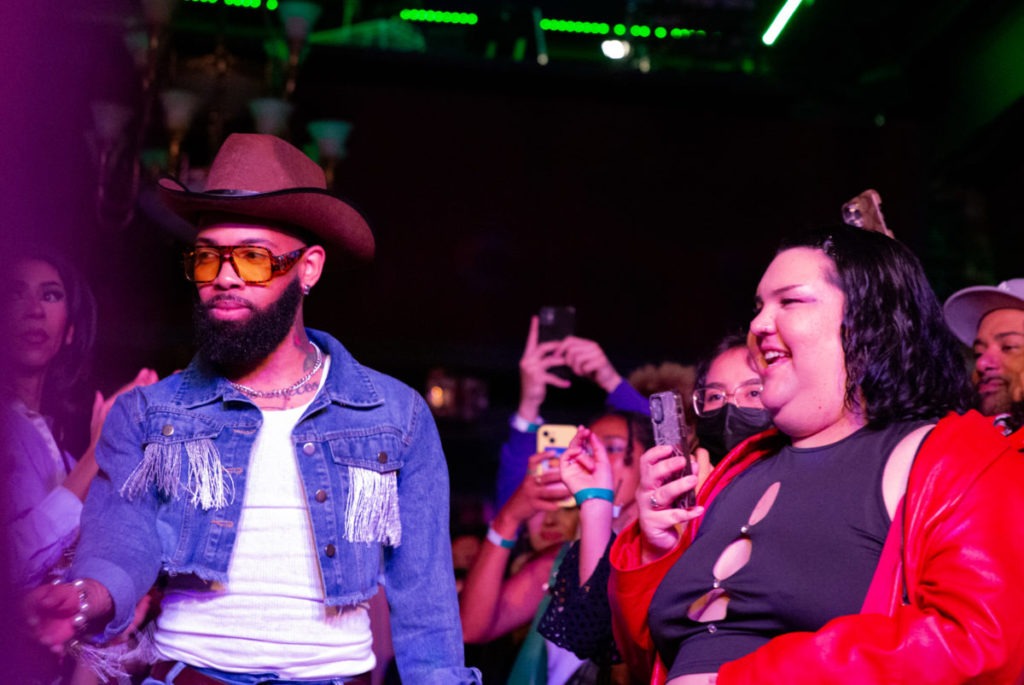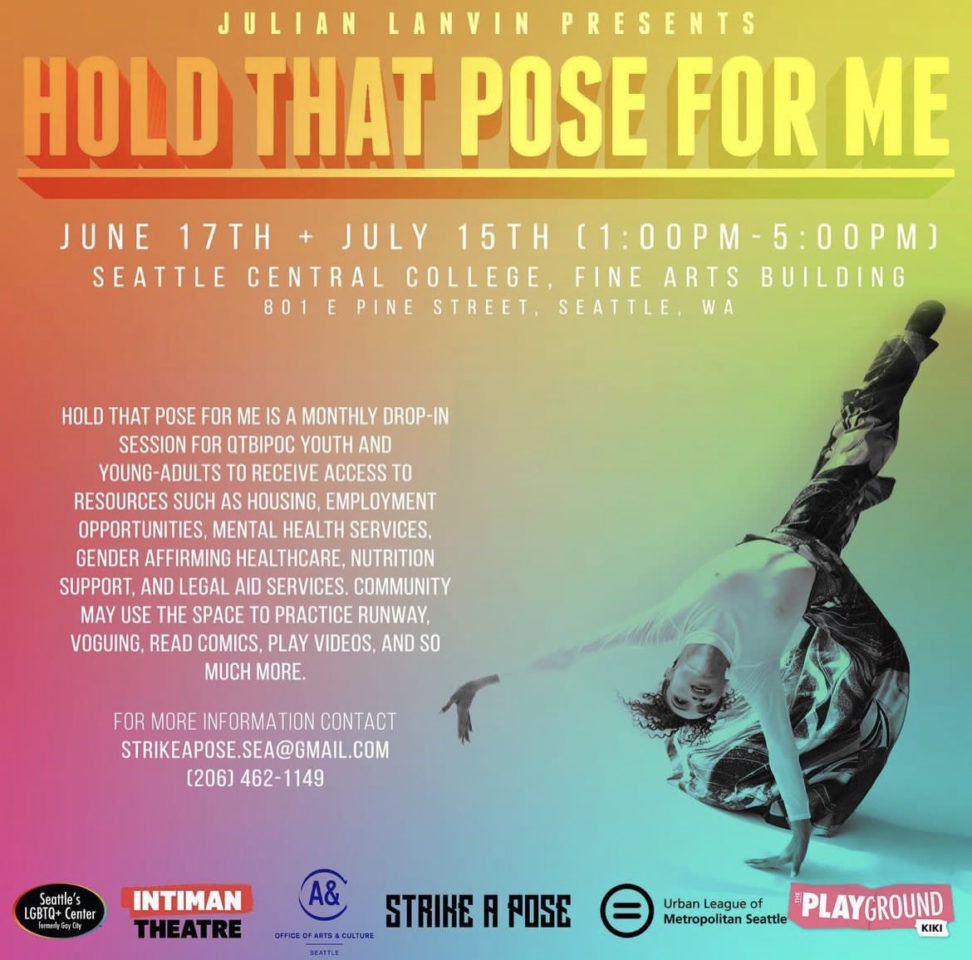Many elements of ballroom culture can be found in mainstream media. Programs like RuPaul’s Drag Race and Pose are sprinkled with moves that have derived from the culture. From the iconic dip to voguing, ballroom culture has made an impact. In Seattle, a small group led by Julian Lanvin has been pioneering a new home for the ball scene.
On Saturday, June 10, people in different houses attended “Strike A Pose” at Julia’s on Broadway. The category: “Rainbow Hoedown”, where individuals must be dressed in their best cowboy/cowgirl/cowperson outfit to participate, incorporating any LGBTQIA+ flag within the effect, there to compete for cash prizes.
Organized by Lanvin, “Strike A Pose” is a monthly event that showcases the talents of Seattle’s different houses. After spending time as a program manager in adolescent health programs in Baltimore, Lavin never expected to be part of Seattle’s developing ballroom scene.
In the past, ballroom has held categories that today can feel outdated. Lanvin explains that categories have been updated to be more inclusive of gender non-conforming (GNC) and non-binary folks, “The biggest additions [in categories] have been more GNC, non-binary categories within ballroom. Because now we are seeing that GNC and Non-binary folks are competing in the ballroom and they want to ensure they are being represented properly.”

Community in Ball is power
Lanvin acknowledges how much of a challenge it can be to bring a positive impact to young adults. A sense of belonging is established when trust is further adhered with connection,. which is why “Strike A Pose” became larger than he ever expected.
“Even though it was in a non-traditional outreach approach it was probably the most effective,” Lanvin says, referring to the way the group has reflected on it’s growing monthly demographics, “and it was being able to reach adolescent young adults that, quite frankly, is one of the hardest groups to reach.” Seeing the numbers of participants and supporters grow, Lanvin felt that “Strike A Pose” became even more vital through the trusted faith its community provided.
When asked why connecting younger individuals was an important factor for the group Lanvin says, “Not just going as far as to helping people and individuals, it’s giving them resources, giving them the extra help that they need, because like growing up, no one really taught [us] how to do that, especially growing up queer. It’s definitely important for the community to have that kind of resource.”
He goes on to explain how the group has been able to provide accessibility and resources all at once. By acknowledging what has been lacking for the community, “Hold That Pose For Me” became established. As a conduit for resources, safe space for practicing voguing and runway, and even going as far as to bring medical professionals, “Hold That Pose For Me” continues the group’s ongoing mission of being by the community, for the community. With two scheduled meet-ups at Seattle Central Community College, June 17 and July 15 from 11am-5pm.

In regards to the visibility of representation for queer BIPOC folks needing this type of space Lanvin explains, “ the lack of representation that’s in these spaces where services are supposed to be provided, they [queer BIPOC folks] felt so many microaggressions and actions and things that they dealt with that continues to perpetuate this ongoing historical trauma that’s been dealt with.”
Skills learned within these connective sessions are ones that individuals will be able to carry throughout their own personal lives. With that in mind there comes two levels that individuals can find themselves joining. In the Kiki scene, the demographic pertains to younger individuals from thirteen to twenty-four years of age. In this level there comes opportunity for people to find their footing, discover more of themselves and continue to bond with those growing alongside them. This also provides mentoring and constructive judging within their age brackets as a way to grow together. The main scene can be described as a more varsity level scene as individuals in this tier have become not only well versed in the categories, but also the infrastructure and history of what ballroom culture is.
A brief history of ballroom
At the height of the late twentieth century, modern ballroom culture originated in New York as a form of resistance, dazzled with self expression as a queer art form. Primarily being a place where Black and brown communities, queer and trans communities, and more marginalized identities would come together in a space that felt safe enough to be themselves. It formed a safe haven for those, youth especially, who found themselves ostracized from their families over the basis of non-heteronormative identity.
Modern ballroom was born out of inclusivity lacking for Black and Brown folks in queer spaces. Many anecdotes can be found when watching documentaries like the critically acclaimed 1990 film “Paris Is Burning”. However, in the 1968 film “The Queen”, viewers get a better insight into the racial discrimination Black and Brown queen’s faced in these so called “safe” spaces.
Houses in ballroom served as surrogate families where teenagers, shortly after coming out to their families and instantly being kicked out onto the streets, would be welcomed into. Houses are headed by a “Mother” and a “Father” figure. Names for these houses came from the head of house’s last name, but can also derive from high fashion brands. This became more renowned during the late 60’s and 70’s, as ball culture continued to grow and youths in need of a home were able to find that during the time.
An end to the night

Through categories, members of the community are given a chance to show off their skills. Appearing like a pure adrenaline rush, spectators who watch can bear witness to the liberation each individual experiences when performing and showcasing their talents.
The way bodies have moved through the categories is beautiful. With control, passion, and absolute joy, individuals found their rhythm in the music. As the time nears to two-thirty am, the event is cut early, with one more song in the lip sync category left. The patrons are mindful and understanding as they make their way out of the venue.
Danielle Jackson, a community member, expressed her appreciation for the culture, “I think it’s really cool, I just like seeing people express themselves, get all dressed up and be themselves. we don’t get to see it all the time… In some places they don’t even have one place like this. And so anything that we can have in Capitol Hill. Especially in this area and like during pride month, this is very important for them. For people to feel represented and feel safe in at least one space.”
The energy that fills the evening is a hopeful reminder that during trying times of queer spaces on the verge of erasure, with the onslaught of anti-LGBTQ+ bills still being introduced, ballroom culture is supportive to the perseverance of queer lives. No matter the uncertainty still intrusive in the mind, any ending to queer joy proves to be impossible at this point.







Be First to Comment